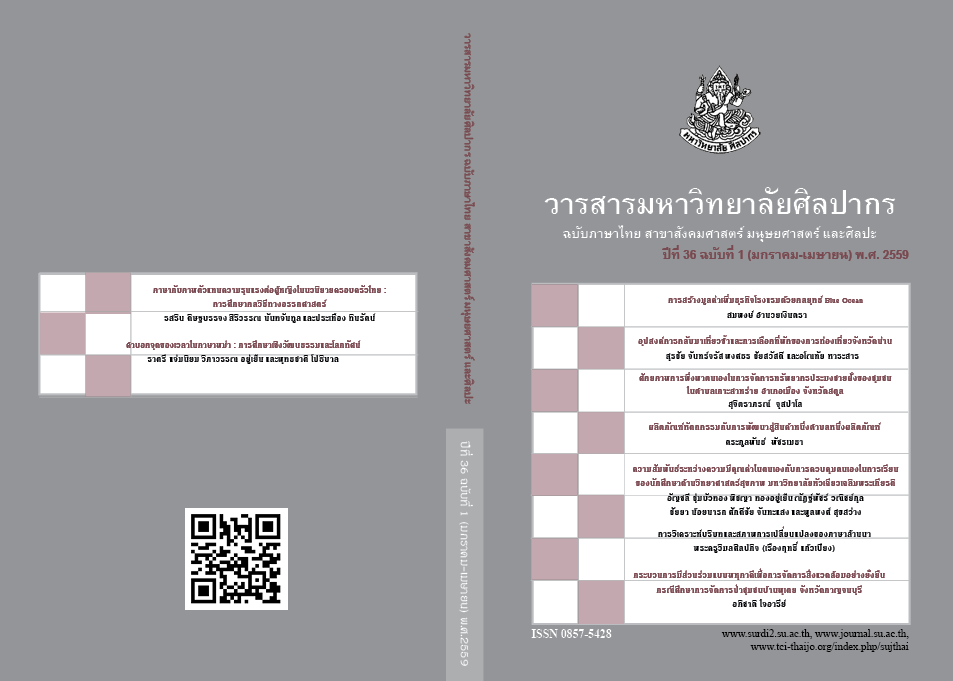ภาษากับภาพตัวแทนความรุนแรงต่อผู้หญิงในนวนิยายครอบครัวไทย : การศึกษากลวิธีทางอรรถศาสตร์ (Language and Representation of Violence against Women in Thai Family Novels: A Study of Semantic Strategies)
Main Article Content
Abstract
การวิจัยครั้งนี้มีวัตถุประสงค์เพื่อศึกษากลวิธีการใช้ภาษาในการนำเสนอภาพตัวแทนความรุนแรงต่อผู้หญิงที่ปรากฏในนวนิยายครอบครัวไทยของนักเขียนนวนิยายยอดนิยม 5 คนที่ได้รับรางวัลศิลปินแห่งชาติ สาขาวรรณศิลป์และได้รับรางวัลจากคณะกรรมการพัฒนาหนังสือแห่งชาติ ได้แก่ กฤษณา อโศกสิน ศรีฟ้า ลดาวัลย์ ว.วินิจฉัยกุล ทมยันตีและปิยะพร ศักดิ์เกษม จำนวน 37 เรื่อง ผลการวิจัยพบกลวิธีทางภาษา คือ กลวิธีทางอรรถศาสตร์ ได้แก่ (1) คำหรือกลุ่มคำที่ใช้เรียกผู้หญิงด้วยถ้อยคำที่รุนแรง (2) คำหรือกลุ่มคำที่แสดงความรุนแรงต่อผู้หญิง คำหรือกลุ่มคำที่ใช้เรียกผู้หญิง
ด้วยถ้อยคำที่รุนแรงที่ปรากฏในนวนิยายครอบครัวไทย ปรากฏในผู้สูงอายุ ผู้ใหญ่ และเด็ก ปรากฏการใช้คำนำหน้าและตามด้วยส่วนประกอบต่างๆ ปรากฏคำเรียก “อี” มากที่สุด รองลงมา คือ “นัง” “ยาย” และ “ไอ้” ลักษณะของถ้อยคำที่ปรากฏแสดงให้เห็นถึงการว่ากล่าว การเหยียบย่ำเพศหญิง คำหรือกลุ่มคำที่แสดงความรุนแรงต่อผู้หญิงที่ปรากฏในนวนิยายครอบครัวไทย ปรากฏ 2 ลักษณะ คือ (1) คำหรือกลุ่มคำที่แสดงความรุนแรงต่อร่างกาย และ (2) คำหรือกลุ่มคำที่แสดงความรุนแรงต่อจิตใจ โดยปรากฏคำหรือกลุ่มคำที่แสดงความรุนแรงทางจิตใจมากกว่าร่างกาย คำหรือกลุ่มคำที่แสดงความรุนแรงต่อจิตใจ ปรากฏทั้งผู้สูงอายุ ผู้ใหญ่ และเด็ก ความรุนแรงต่อจิตใจที่พบ ปรากฏทั้งกลวิธีทางวัจนภาษาและอวัจนภาษา กลวิธีทางวัจนภาษากล่าวถึงการใช้ถ้อยคำว่ากล่าว ด่าทอ การดูถูกเหยียดหยาม การไม่ให้เกียรติ การเหยียบย่ำสถานภาพของผู้หญิง ส่วนกลวิธีทางอวัจนภาษาที่พบ คือ การใช้แววตา น้ำเสียงที่แสดงความเกลียดชัง ไม่พอใจ และการแสดงออกทางกาย ส่วนคำหรือกลุ่มคำที่แสดงความรุนแรงต่อร่างกาย กล่าวถึงการทำร้ายร่างกายตามส่วนต่าง ๆ รวมถึงการบังคับข่มขู่ว่าจะกระทำ และปรากฏการกระทำความรุนแรงทางเพศเข้ามาเกี่ยวข้องด้วย นั่นคือ การถูกข่มขืน
Downloads
Article Details
References
Charoenporn, S. (2006). Women and Society in the Thai Novels during the Economic Bubble. Bangkok: Mathichon
Deepadung, S. (2009). Introduction to Pragmatics (วัจนปฏิบัติศาสตร์เบื้องต้น). Bangkok: Research Institute for Languages and Cultures of Asia, MahidolUniversity.
Fairclough, N. (1990). Language and Power. Cambridge: Cambridge University Press.
Hall, S. (1997). Representation: Cultural Representations and Signifying Practice. London: SAGE.
Intarajit, O. and Karinchai, N. (1999). Domestic Violence against Thai Women & Children (ผู้หญิงและเด็ก: เหยื่อความรุนแรงในครอบครัว). Bangkok:Hotline Institute of Psychology.
Jorntes, S. (2006). An Analysis of Characterization of the Family’s Role in V.Vinicchaikul’s Novels (วิเคราะห์บทบาทครอบครัวที่มีต่อตัวละครในนวนิยายของว.วินิจฉัยกุล). Master’s dissertation, Silpakorn University, Nakhon Pathom, Thailand.
Kaewthep, K. (2002). Media and Cultural Studies in the Thai Society. Journal of Political Science, 23(March2002): 51-97.
Krisana Asoksin. (n.d.). Rua manut 1 (เรือมนุษย์ เล่ม 1). Bangkok: Chokchai Thewet Publishing.
Krisana Asoksin. (n.d.). Rua manut 2 (เรือมนุษย์ เล่ม 2). Bangkok: Chokchai Thewet Publishing.
Krisana Asoksin. (1985). Kingmalika (กิ่งมัลลิกา). Bangkok: Chokchai Thewet Publishing.
Krisana Asoksin. (2002). Rakkaew (รากแก้ว) (4th ed.). Bangkok: Puen-dee Publishing.
Krisana Asoksin. (2007). Sawan-biang (สวรรค์เบี่ยง) (2th ed.). Bangkok: Puen-deePublishing.
Krisana Asoksin. (2008). Nam-phueng Khom (น้ำผึ้งขม). Bangkok: Puen-dee Publishing.Nakornthap, T. (1976). Authourship (วิชาการประพันธ์). Bangkok: AksornCharoentat Publishing.
Pakdeepumin, J. (2009). Kamin Kab Poon (ขมิ้นกับปูน) (5th ed.). Bangkok: Puen-dee Publishing.
Phattharakuk, W. (2009). Research methodology in social sciences (ระเบียบวิธีวิจัยทางสังคมศาสตร์). Bangkok: Chulalongkorn University.
Ramathibodi Hospital, Teen Clinic. (2013). Thailand Attached Rank Seventh Violence on Women and Children (ไทยติดอับดับ 7 ใช้ความรุนแรงในเด็กและสตรี). [Online]. Retrieved January 26, 2015 from http://www.teenrama.com/oldnews/Jan’56/jan5.html.
Royal Institution. (2013). Royal Institute Dictionary 2011. Bangkok: Royal Instittution
Sajjapant, R.(1983). General Knowledge on Thai Language. Bangkok:Department of Thai and Eastern Languages, Ramkhamhaeng University.
Sakkasem, P. (2002). Lub-Lae-Lai-Mek (ลับแลลายเมฆ). Bangkok: Doublie Nine Publishing.
Srifa Ladawaln. (n.d.). Oh-ma-da (โอ้มาดา). Bangkok: Klungwittaya Publishing.
Sriprasert, P. (2005). Family Violence: A Case of Wife Abuse (ความรุนแรงในครอบครัว: กรณีการถูกทำร้ายของภรรยา). Master’s dissertation,Kasetsart University, Bangkok, Thailand.
Suphap, S. (1997). Sociology (สังคมวิทยา). Bangkok: Thai Watana Panich.
Suwattanawanit, P. (2005). Domestic Violence in which Female is the Offender, Studied from Thai Novels during 1978-2002. In Supporting Documents for the 4th Annual Meeting on Humanities Topic Bias towards Culture, Violence towards Life, 23-25 March 2005.
Tamayanti. (2004). An-Ta-Kan (อันธการ) (4th ed.). Bangkok: NabaanwannagumPublishing.
Tamayanti. (2013). Lah (ล่า) (9th ed.). Bangkok: Nabaanwannagum Publishing.Thai Health Promotion Foundation. (2013). Stop Domestic Violence Stop Violence against Women (หยุดความรุนแรงในครอบครัว ยุติความรุนแรงต่อผู้หญิง). [Online]. Retrieved November 22, 2013 from http:// www.thaihealth.or.th/partner/arti_partner/37754
V. Vinitchaikul. (1989). Sen-mai-see-ngen 1 (เส้นไหมสีเงิน เล่ม 1). Bangkok: Bumrungsarn Publishing
V. Vinitchaikul. (1989). Sen-mai-see-ngen 2 (เส้นไหมสีเงิน เล่ม 2). Bangkok Bumrungsarn Publishing.
V Vinitchaikul. (1996). Tan-ta-wan (ทานตะวัน) (2nd ed). Bangkok: Dokya Publishing.Wongsiri, M. (1992). Perceptions on Families’ Values in the Thai Society. A Report on Research’s Finding, Institute for Population and Social Research Chulalongkorn University.


